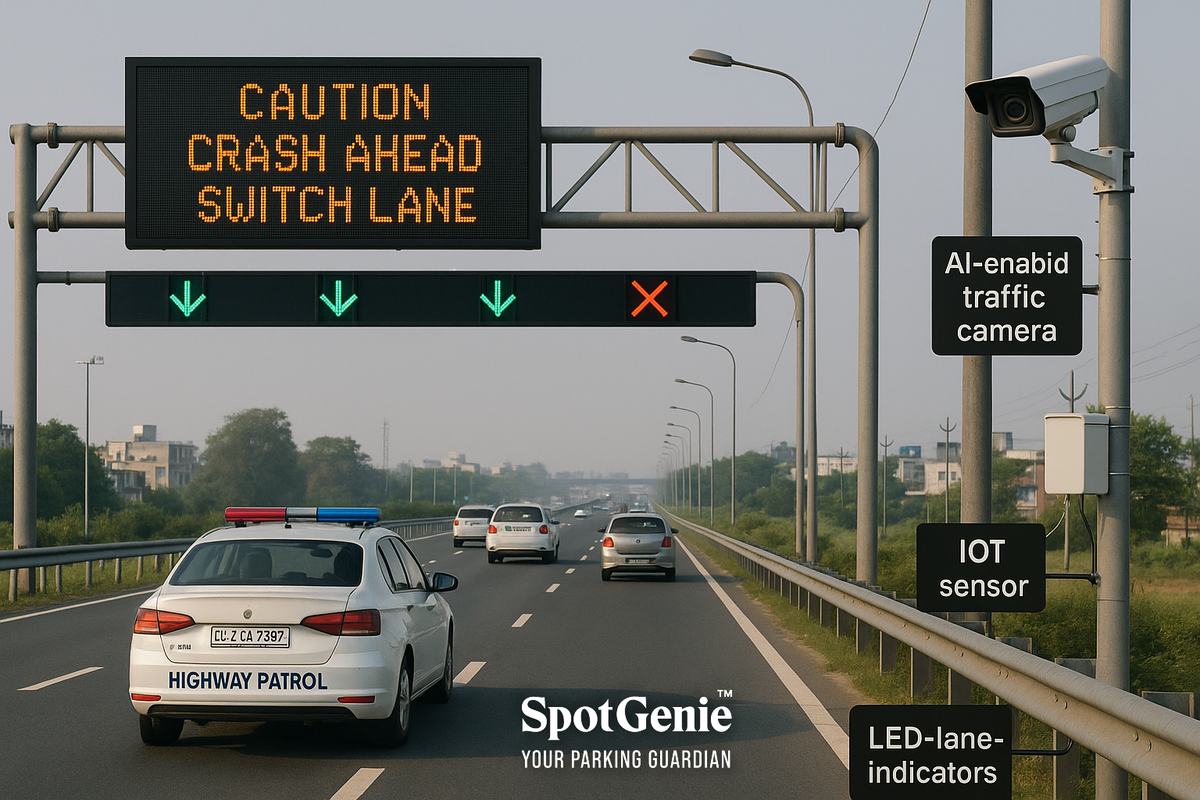AI & IoT-Based Smart Highways in India
Explore India’s pilot smart highway corridors with AI monitoring, IoT street sensors, traffic violation detection, and real-time incident response.

Smart Highways in India: AI & IoT Transform Road Safety
SpotGenie Gyaan explores how Indian highways are becoming more intelligent-with real-time alerts, AI-based enforcement, and IoT infrastructure that could redefine your driving experience.
What Makes a Highway Smart?
Smart highways combine AI, IoT, and advanced data systems to automate traffic monitoring, enforce safety, and improve incident response. Cameras detect over-speeding, wrong-way driving, or stalled vehicles. Sensors track road temperature and congestion. Smart signboards guide drivers based on live road conditions.
Where It's Already Happening: Real-Life Corridors
- Dwarka Expressway (Delhi–Gurgaon): India's first AI-based Advanced Traffic Management System (ATMS) went live in 2024, capable of detecting 14 violations like helmetless riding, triple-riding, wrong-lane entry, and jaywalking. This 29 km stretch features high-definition cameras linked to traffic control rooms that generate e-challans automatically.
- Tambaram–Tindivanam NH‑32 (Tamil Nadu): The 107 km highway recently became Tamil Nadu's first IoT-enabled corridor. It has GPS-linked smart poles, real-time emergency vehicle tracking, and smart lighting that dims or brightens based on traffic flow. In a pilot phase, response time to an ambulance request reduced by nearly 40%.
- Delhi–Mumbai Expressway Pilot Zone: In Madhya Pradesh, a segment is equipped with radar-integrated AI cameras supplied by Bitsensing (South Korea). These detect lane changes and stalled vehicles, sending alerts to a NHAI monitoring station. Authorities have noted faster intervention in crash zones due to this setup.
- Mumbai–Nagpur Samruddhi Mahamarg: Often called India's fastest expressway, this 701 km route features weigh-in-motion systems every 20 km and high-speed monitoring every 2 km. In 2024, a speeding vehicle was detected crossing 180 km/h and was intercepted within 7 minutes, thanks to the integrated system.
Technology Driving the Change
- AI Surveillance: Automatically captures images of violations, such as riding without seat belts or helmet, and forwards it to the enforcement system.
- IoT Smart Poles: Deployed in Tamil Nadu to manage dynamic lighting and share real-time alerts on road hazards via cloud-connected systems.
- Dynamic Message Boards: Display live messages like "Fog Ahead, Slow Down” or "Crash in Left Lane – Shift Right,” seen prominently on Dwarka Expressway and Samruddhi corridor.
Why Smart Highways Matter
- Improved Response Time: On the Dwarka Expressway, emergency services have seen a 25–30% improvement in response time since ATMS activation.
- Data-Based Enforcement: Tamil Nadu's NH‑32 e-fined over 2,000 speeding drivers in its first 90 days using IoT-synced radar systems.
- Safer Navigation: A trucker navigating the Delhi–Mumbai Expressway now receives live lane alerts via navigation apps integrated with corridor sensors, reducing fatigue-related mishaps.
Roadblocks to Full Adoption
- Network Consistency: Smart features rely on uninterrupted telecom and cloud sync, which is still patchy in rural zones.
- Capital Investment: Setting up edge AI and IoT infrastructure costs ₹15–20 crore per 100 km on average.
- Driver Awareness: While systems are live, many local drivers still ignore digital warnings due to lack of sensitization.
Who Should Pay Attention?
- Daily Commuters: Use apps like Mappls or Google Maps integrated with real-time highway data to plan better, safer drives.
- Commercial Fleets: Logistics operators using the Samruddhi and Delhi–Mumbai corridors report 18–20% time savings due to predictive alerts.
- Highway Authorities: Should adopt performance dashboards and live data audits to guide infrastructure improvements.
Conclusion
India's highways are no longer passive roads-they are intelligent, evolving systems that alert, protect, and predict. From Tamil Nadu's IoT milestones to Delhi's AI surveillance, these projects mark a new era of digital mobility infrastructure.
Follow us on:
🅾 Instagram |
ⓕ Facebook |
𝕏 X |
▶️ YouTube |
🟢 WhatsApp



